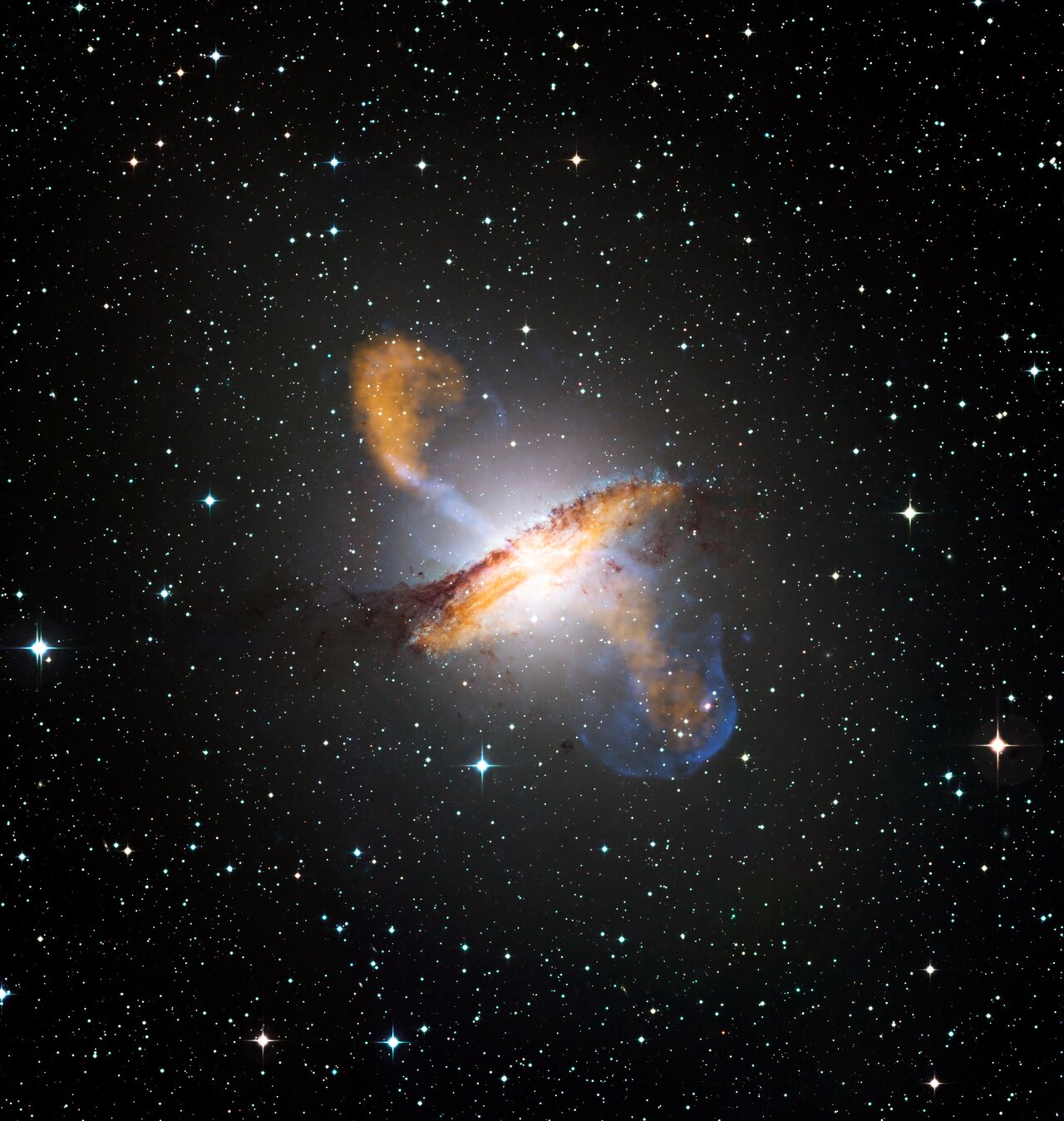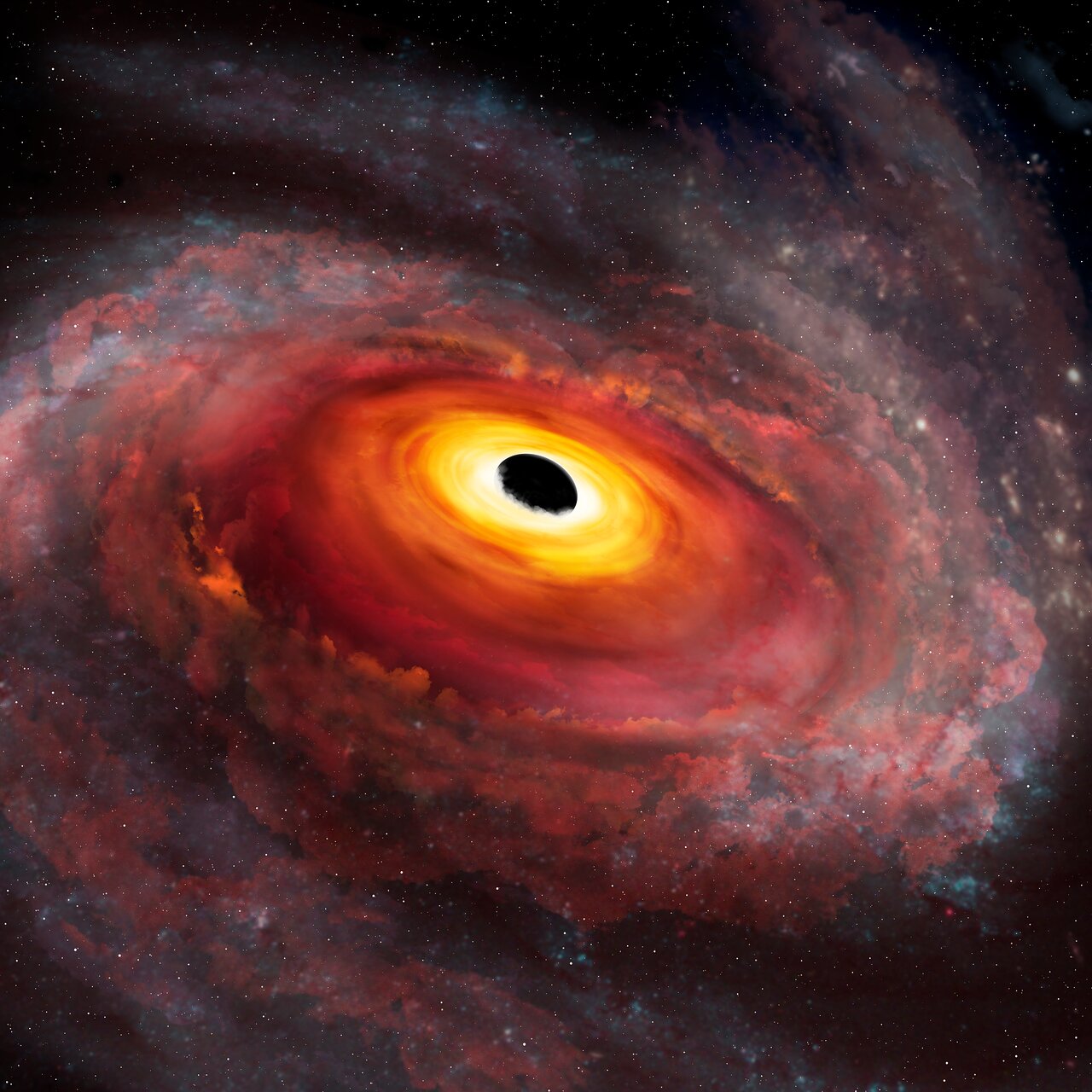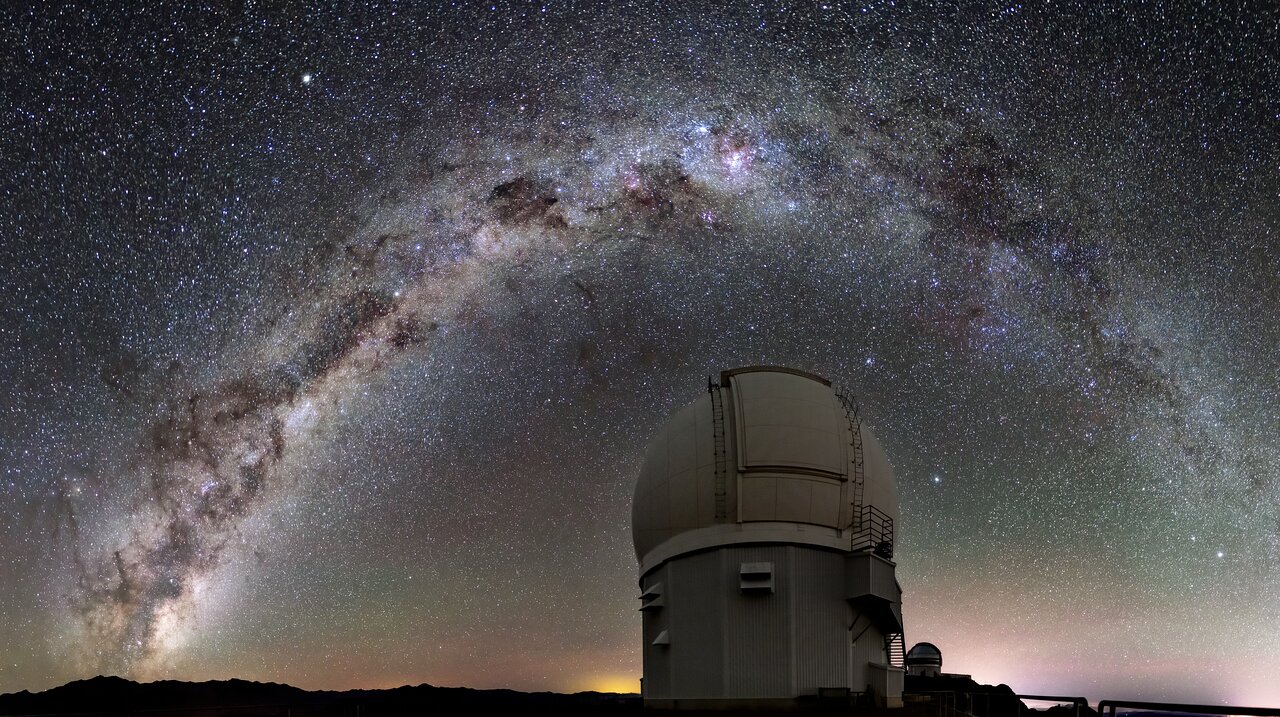
An Enigmatic Cosmic Crime Scene
Buried within NOIRLab’s unWISE archive lies a remarkable tidal disruption event, overlooked for many years because of its unusual location and characteristics
Profile
Name: SOuthern Astrophysical Research (SOAR) Telescope
Location: Cerro Pachón, Chile
Optical design: Ritchey-Chrétien
Primary mirror diameter: 4.1 meters
Operational waveband: Optical to near-infrared
First light: 2006
Altitude: 2713 meters
Science goals: To produce high-resolution imagery and spectroscopic data of the southern sky
3 Aug. 2023
A vivid flash ignites the dust-clogged spiral galaxy NGC 7392 as an unlucky star treads too closely to the supermassive black hole at its heart. In a feeding frenzy, the black hole’s immense gravity not only spaghettifies light itself, but also strips the star of its gas and stellar debris which then accretes into a blazing disk. For a brief moment, the accretion delivers a powerful emission flare into its cosmic vicinity, which includes Earth at only 100 million light-years away. Despite being one of the brightest and closest tidal disruption events detected in the last decade, this grandiose ‘cosmic crime scene’ would go unnoticed for several years. How could such a brilliant phenomenon be overlooked?
Alongside the Goodman Spectrograph, the SPARTAN Camera at SOAR also contributed to the study by providing a multi-color near-infrared image of NGC 7392.
An Interstellar Disturbance
In the center of almost every large galaxy lies a supermassive black hole, which exerts its gravitational influence on surrounding celestial objects. When a star wanders too close, the black hole’s tidal forces overpower the star’s own gravity, tearing it apart in what’s known as a tidal disruption event (TDE). As the star’s material falls into the black hole, some of the gas temporarily collects around the black hole’s event horizon, forming a superheated band called an accretion disk. The extreme speeds reached by the band increasingly heat up this debris, producing electromagnetic radiation across the spectrum.
This transient emission is the flare we detect here on Earth, letting us know that a TDE has taken place. Most TDEs identified so far had luminosities that peaked from the visible to the X-ray portions of the electromagnetic spectrum, and were commonly found in a category of galaxies called the green valley. These green valley galaxies fall between the active starburst blue galaxies and the passive, sedentary red galaxies. In other words, they form stars at a slow and steady rate, much like our own Milky Way galaxy.
Against a relatively quiet background, TDEs and their blinding emission flares should surely stand out. Interestingly, this was not the case for NGC 7392’s TDE, with the scientific ‘phone-book’ designation WTP 14adbjsh. Contrary to the notion of TDEs originating in relatively quiescent galaxies, NGC 7392 is actually brimming with active stellar nurseries and dynamic clouds of cosmic dust. Owing to the thick swathes of interfering gas, any of WTP 14adbjsh’s optical and X-ray flares were essentially smothered, rendering it imperceptible to astronomers’ observations for seven years.
Diving into the Data Archives
The study of TDEs has been rapidly evolving in the last decade, especially with the advent of infrared astronomy. The ability of infrared light to penetrate the interstellar medium has proven indispensable when it comes to observing astronomical phenomena in dusty environments, making it an exciting time for scientists to begin searching for TDEs in the infrared.
Determined to venture into this intriguing realm, Christos Panagiotou — postdoctoral scholar at the MIT Kavli Institute for Astrophysics and Space Research — and his colleagues decided to investigate archival data taken from NASA’s Near-Earth Object Wide-Field Infrared Survey Explorer (NEOWISE), which scans the entire sky. “We were hoping to get a better understanding of how TDEs look in this rather overlooked wavelength regime, and to utilize this information to improve our knowledge of TDEs in general,” he said. Kishalay De, Einstein Fellow at MIT, performed the all-sky infrared image reprocessing.
“Infrared light's ability to penetrate the interstellar medium has proven indispensable when it comes to observing in active environments, making it an exciting time for scientists to search for TDEs in the infrared.”
What they found in the summer of 2022 was the transient emission WTP 14adbjsh, its luminosity peaking in 2015 from within NGC 7392 and decaying characteristically like a TDE. The detection was made in the mid-infrared spectrum with no sign of visible or X-ray flares whatsoever.
“What’s very unusual about this case is that the discovery was made using infrared data,” says NOIRLab astronomer Aaron Meisner, “whereas most tidal disruption events are detected in visible light, or even X-ray or ultraviolet light.”
Meisner, a co-author of the study, is a lead researcher on NOIRLab’s unWISE project, aimed at creating custom NEOWISE sky maps and catalogs that are served by NOIRLab’s Community Science and Data Center. One of these images revealed WTP 14adbjsh’s bright emission flare hiding in plain sight within our cosmic neighborhood.
Even more unexpected is what was revealed by the spectra obtained from NOIRLab’s SOuthern Astrophysical Research (SOAR) Telescope on Cerro Pachón in Chile. Using the Goodman High Throughput Spectrograph, SOAR established that NGC 7392 was not a green valley galaxy, but an active star-forming one instead. Suddenly, the reason for overlooking WTP 14adbjsh shifted into focus: despite its unmistakable flare, the dynamic climate of NGC 7392 stifled any of its radiant evidence — all except for its infrared light.
Disrupting Space and Time
Putting all the clues together, the study shows us that our current understanding of TDEs is incomplete. The spectroscopy from SOAR was especially critical in identifying that TDEs do not necessarily occur in more passive galaxies and challenging our existing notions of these spectacular events and where they take place.
“This was the brightest extragalactic transient in the entire unWISE database — 10 years of the whole sky — and yet nobody had noticed it for seven years,” Meisner remarks. “The fact that this was an extremely bright explosion in the infrared, but not seen at all in visible light, and that it was one of the closest tidal disruption events detected in more than a decade, all suggests that there’s a missing population of tidal disruption events that we had never seen before.”
“Despite its unmistakable flare, the dynamic climate of NGC 7392 stifled any of WTP 14adbjsh’s radiant evidence — all except for its infrared light.”
In general, TDE research helps shed light on many astrophysical phenomena, from the properties of supermassive black holes in the centers of galaxies to the physics of accretion disks themselves. Utilizing infrared astronomy in the search for TDEs will help scientists gain a better understanding of their physics, and may possibly reveal other high-energy events enshrouded in the gas and dust of larger galaxies.
Panagiotou further comments: “It is exciting to infer that by studying TDEs detected across the whole electromagnetic spectrum we will be able to improve our knowledge of these fascinating transient phenomena in the near future.”
Additionally, WTP 14adbjsh was a nuclear flare that did not last long by astronomical standards, likely only a few years. SOAR’s observation was enabled by NOIRLab’s Astronomical Event Observatory Network (AEON) initiative to advance and promote time-domain astronomy, which studies how celestial objects change over time. While many events in the Universe occur on cosmically long timescales, there are others like TDEs and supernovae that could disappear long before we have a chance to observe them. NGC 7392’s TDE happened to slip through the cracks not just because of its muddled visibility, but also thanks to its fleeting nature.
“This was the brightest extragalactic transient in the entire unWISE database — 10 years of the whole sky — and yet, nobody had noticed it for seven years.”
Time-domain astronomy is growing in relevancy, especially as we enter the era of the Legacy Survey of Space and Time (LSST) to be carried out by the Vera C. Rubin Observatory. As Rubin discovers more transients, SOAR and AEON will play integral roles with follow-up observations to enhance our understanding of the night sky and to ensure fewer time-sensitive cosmic events go undetected.




